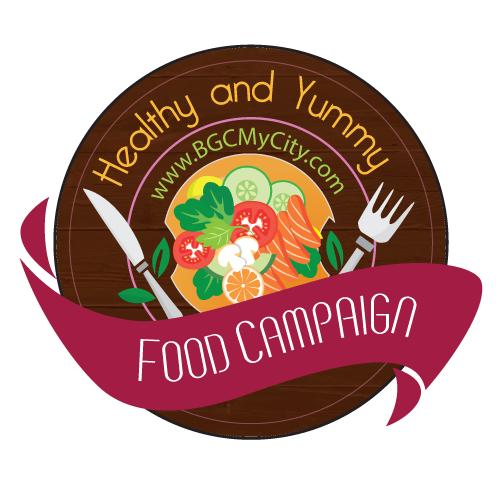This is not a secret: Eating healthy is a main contributor to a long
and happy life. Together with exercise, these are the major ways that we
can make a big difference to our own health. If you do not eat right,
you will have to work extra hard to undo the damage done, if it can be
undone at all.
Why do people not eat right? There can be many reasons. One is a
lack of awareness that our current diet contains too much of stuff that
is bad for our health. In order to help members of our community eat
healthier, we have prepared a series of articles that aim to inform:
what are the food ingredients that we should watch out for, where to
find the healthier alternatives, and what the currently popular
lifestyle diets are about:
- Kitchen for healthy cooking in The Fort – healthy cooking ingredients and where to find them in The Fort
- Going Organic in The Fort
- Vegetarian dining places in The Fort
- Healthy Eat Outs in The Fort – criteria in choosing restaurants for health
- Eat Like a Caveman in The Fort – explains paleolithic diet and other lifestyle diets
In addition, we have put our research results about healthy eating in
an exhibition that will be held in Serendra Piazza from October 15 to
18, 2015. There will be health talks and booths on October 16th (Friday)
and 17th (Saturday). Do visit us and be part of our sharing.
In the first article of the series on Eating Healthy in The Fort, we will
discuss the three most commonly used kitchen ingredients, and how to
make sure that they are consumed in a way that contributes to our good
health. We will also introduce three healthy food ingredients that can
be used as staple in our diet.
Ingredient for seasoning #1 – Salt
Too much salt is not good for you, we know. Salt is made from sodium
chloride, and if consumed at high levels it will elevate our blood
pressure, leading to strokes, heart failure and heart disease. However,
too little salt is also bad for us. Salt supplies electrolyte sodium to
your diet (maintains fluid balance within your cells, for contracting
your muscles and for transmitting nerve impulses). A 2010 Harvard study
linked low-salt diets to an immediate onset of insulin resistance
(precursor to type 2 diabetes).
The best approach is therefore to control the amount of salt intake.
Gradually reducing the amount of salt used in a dish is a good way to
achieve that. The use of naturally flavored salt, such as garlic salt
and celery salt, or sea salt which contains flavors from the mineral
content, may reduce the need for larger quantity of total salt intake.
Salts which contain a combination of sodium and potassium chloride
are now available in Metro Manila. One of the available and used
products is Pan Salt. Pan salt contains less sodium and more potassium
than regular salt.

Sodium salt alternative: potassium salt can be found in Rustan’s Marketplace at Central Square, BHS.
Ingredient for seasoning #2 – Sugar
Admit it, we love sugar. We cannot live without sugar. Yet too much
sugar is bad for us for so many reasons, such as weight gain, type 2
diabetes, metabolic syndrome and high triglyceride levels. All of these
boost your risk of heart disease. And refined sugar is the worst kind of
sugar. It contains a lot of calories and no nutrients like vitamins,
fiber or minerals. It also causes spikes in insulin and blood sugar
levels (high glycemic index). Somehow, our body has trouble coping with
such spikes and they make us sick (a high glycemic index increases the
risk of breast, prostate, colorectal, and pancreatic cancers as well as
developing type 2 diabetes and cardiovascular disease).
If we are looking for a sweetener to be used for general cooking,
refined white sugar is the most versatile. It is also cheap, because of
the large scale of production. Substitutes are likely to be more
expensive. However, if we can adjust our palate to enjoy food with lower
level of sweetness, we do not need so much of refined sugar or its
substitute.
We do not recommend using artificial sweeteners, as they have their
own health issues and taste problems. For cooking, we would suggest
using raw sugar. Yes, it is still made from sugar cane, but it is less
refined. There are also other less refined sugar such as Muscovado sugar
that contains more nutrients in the form of vitamins and minerals.
Coconut palm sugar, which is plentiful here in the Philippines, is also a
recommended refined sugar substitute by Organic Lifestyle Magazine. At
the end of the day, though, these alternatives still have high calories
and we should try to consume less.
Stevia rebaudiana (Bertoni), a sugar substitute that comes from a plant
that is native to Paraguay and Brazil, has a very low glycemic index.
Stevia has no calories, and it is 200 times sweeter than sugar in the
same concentration. But there are some health concerns surrounding the
stevia plant. Stevia may cause low blood pressure, which would be of
concern to some taking blood pressure medications. It is also quite
expensive by comparison. Use in moderation.

Stevia can be found at Robinsons Select at Burgos Circle, although they are placed in the tea section, not in the sugar section.
Ingredient for cooking – Oil
Cooking oil is often used to raise the temperature of food
ingredients so as to bring out the flavor of the food using different
cooking methods, such as stir-frying, deep frying, and sauteeing.
However, cooking oil can become a health hazard when it reaches its
smoke point. Oil in unrefined form contains substances such as minerals,
enzymes and other compounds that will burn or produce bad taste when
heated. Toxins may be produced when these substances break down, either
through time or as a result of heating it. To raise the smoke
temperature of a cooking oil, manufacturers use industrial methods to
remove these substances, e.g. bleaching, filtering, and
high-temperature heating. The objective is to extend the shelf life of
the oil. Often, the refined oil has its flavor removed, leaving a
neutral taste, which can be either a good thing or bad, depending on its
use.
To slow down the degradation of cooking oil, keep it air tight in a dry place, and away from light and heat.
Thus, one health aspect of cooking oil is to take into consideration
its smoke point when using it for a particular cooking method, so that
we do not hit the smoke point and create toxins in the oil.
Another health aspect of cooking oil is the content of different
types of fat in it. While new studies question the established wisdom
that saturated fat is bad for the heart, no study has disputed that
trans fat increases the risk of getting heart diseases. Trans fat is
found in margarine, because margarine is made from partially
hydrogenated vegetable oil, which in turn contains trans fat. We should
also use oil that is low in saturated fat (bad fat), high in
monounsaturated fat which promotes HDL (good cholesterol) and lowers LDL
(bad cholesterol). Polyunsaturated fat is also better than trans fat
and saturated fat, but not as good as monounsaturated fat. Any oil,
however, has high calories level and should be consumed in moderation.
The two most recommended cooking oils are : extra virgin olive oil
(smoke point of 180 degrees Celsius), which, when used in salads and
sauteeing, has high monounsaturated fat (78%) and low in saturated fat
(14%), as well as antioxidents called polyphenols; canola oil, which has
high monounsaturated fat (61%) and the lowest saturated fat among
vegetable oils (7%).

Extra virgin olive oil can be found in nearly all major supermarkets in Bonifacio Global City.
Trendy Healthy Food Ingredient #1 – Quinoa
This food gained tremendous popularity in recent years. According to
Huffington Post, “It’s a complete protein — meaning it contains all
nine of the essential amino acids which cannot be made by the body and
therefore must come from food”. Also, it is a seed, not a grain (but who
really cares). It grows from a plant in the goosefoot family, which
also produces edibles such as chard and spinach. Quinoa has long been a
staple ingredient, dating back to pre-Columbian civilizations in the
Andes of Peru and Bolivia. While Quinoa is originated from Bolivia,
Quinoa cultivation is spreading and now occurs in more than 70
countries, including France, England, Sweden, Denmark, Holland and
Italy. It is also being developed successfully in Kenya, India and the
United States. The United Nations announced 2013 as the international
year of Quinoa.
When cooked, Quinoa is like a translucent rice, only that it is disc
shaped rather than oval shape. It has little or no taste, but can be a
little chewy. When used in a salad, it can acquire the flavor of the
dressing and become tasty.

Quinoa is sold in healthy food stores as well as supermarkets like Rustan’s, Robinson’s Select and SM Aura.
Trendy Healthy Food Ingredient #2 – Soba
Soba is a Japanese noodle made from buckwheat. Buckwheat is the
fruit of a plant that is related to rhubarb. “Buckwheat contains more
protein than grains and is not deficient in the amino acid lysine as
most grains are, so the protein is more nutritionally complete. That
makes it a particularly good choice for vegetarians. It’s an excellent
source of magnesium, a boon to your blood pressure. A phytochemical in
buckwheat may be beneficial in the management of diabetes; studies show
it may have the ability to lower blood glucose levels. It’s also a good
source of fiber.”

Soba can be found in some supermarkets as well as Japanese and Korean convenience stores in BGC.
Trendy Healthy Food Ingredient #3 – Brown Rice
Brown rice is technically rice which has undergone milling only once and whose bran and germ are still intact.
Polished rice losses substantial nutrients including 80% of Vitamin
B1, 67% of Vitamin B3, 90% of Vitamin B6, 50% of the phosphorous, 50% of
the iron and all the dietary fiber and essential fatty acids.
In terms of taste, brown rice tastes less sweet than plain rice, but
it does not mean that it tastes bad. In fact, after a while, you may
prefer the taste of brown rice to plain rice. It takes more water to
cook brown rice, else some people may find brown rice too hard compared
to white rice.
Image below is a comparison of the health benefits of quinoa versus
those of brown rice, from www.prevention.com:
the conclusion is that both are very good for our health, especially
when compared against the usual staple food like white rice, white bread
or potato.

Quinoa vs brown rice: both are winners.

Brown rice can be found in several supermarkets in BGC. Some restaurants also serve brown rice.
We do not need to replace all our familiar cooking ingredients, or
stop eating rice or other grain products such as bread. If we can
substitute some of our regular food items with those listed above every
now and then, and reduce the consumption of sugar and salt, we are
already on the way to a healthier eating habit.
Please remember to visit our Healthy Yummy Campaign event at
Serendra Piazza on October 15 to 18, 2015 in which you will find even more
information on healthy eating. See you there!








